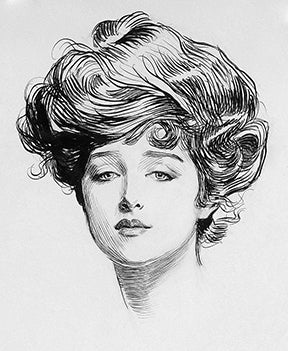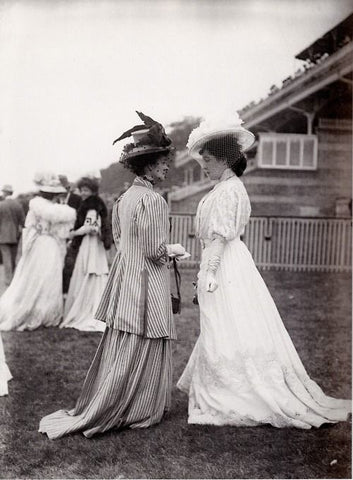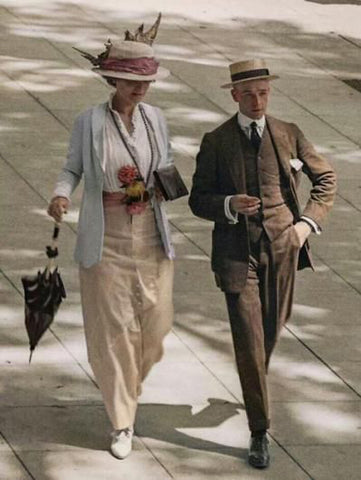- Home
- About
-
Shop
-
Sewing Patterns
-
Fabric
- Sewing Supplies
- Folkwear Clothing
-
- Blog
- Customer Gallery
- Contact
April 09, 2022 2 Comments on The Beginning of the End for the Corset
The period between the American Civil War and the Great War was a time of vast change, setting the stage for the modern world. Like any period of change it came with conflicting dynamics. When Mark Twain coined this era “The Gilded Age,” by no means a compliment, he meant that the period was glittering on the surface but corrupt underneath.

While, greed and corruption was unbridled, it also enabled developments in industry and technology that would accelerate changes in every aspect of life, including fashion.
As you will discover, the Folkwear 265 Afternoon Tea Dress and the 266 Greek Island Dress each played a part in the shifting attitudes of women who had never known life without the corset. When you think of how revolutionary this would have been for women, any thought towards shedding the corset must have seemed radical. Keep reading to find out how two garments Folkwear has patterns for influenced how the Gilded Age would unfolded, setting the stage for a tectonic shift in fashion.
From a modern perspective, we tend to think of fashion history as “before the corset” and “after the corset.” The Gilded Age was a time that started to shift attitudes for women and what they wore. The cinched up Edwardian Gibson Girl did not give way to the liberated Flapper of the Roaring Twenties overnight, but rather she signified the beginning of a transition that would span twenty years and embodied the attitudes that gave rise to change. In essence it was the Gibson Girl that sent out the invitations and it was the flapper that eventually crashed the party.
With the Gilded Age came America’s Second Industrial Revolution, lead by the Titans of Industry. Mass production, shipping, and communications expanded business like never before. The country expanded both outward and upward due to new technologies in the steel industry, which caused the railway to boom outward and the sky scrapper was born. Urbanization exploded with immigrants and farm laborers lured by the hope of a better way of life. New technologies like the telephone made business transactions possible on the spot. Refrigeration allowed for more food varieties to move everywhere via the train, hence the modern beef industry was born. The electric light bulb enabled work to continue into the night. Cities were being built with water, electricity, gas, and sewer systems all in the promise of a modern life. Textile production increase exponentially and new types of fabrics were abundant. Department stores and mail order catalogs flogged their wares nationally, opening up reasonably priced goods and ready made clothing to the far reaches of the country. For the first time, new immigrants were able to blend in and look "American".


Textile Mill
Mass production of consumer goods exploded, which created a better standard of living and expanded the middle class. But in its wake, skilled labor was devastated, forcing the poor to work for low wages, resulting in more extreme poverty. The wealthy new American Tycoons continued to get richer, while doing their best to emulate and out-do their European aristocratic role models. This was the beginning of the country becoming an industrial world power.
Seemingly out of no where, an illustrator named Charles Dana Gibson (1867-1944) made a fictitious drawing of the ideal “New Woman.” She was known as the Gibson Girl and was featured in the popular magazines such as Scribner's Harpers, Collier's, and the Century.

His creation resonated with Edwardian women and would serve as a role model for overlapping generations (1890’s-1914). Gibson’s illustration was not a figment of his imagination. He gave the glamorous “Gibson Girl” a fully illustrious life, with aspirations, and an aesthetic lead by independent pursuits. This illustrated young woman would serve as an icon to American women, introducing them to a new version of themselves, with a set of standards for beauty, fashion, and manners.

Charles Dana Gibson illustration entitled "The Weaker Sex."
The Library of Congress described the Gibson Girl:
“…as an independent and often well-educated, young woman poised to enjoy a more visible and active role in the public arena than women of preceding generations. They agreed [writers of the 1890s and early 1900s] that the Gibson Girl represented the visual ideal of this new phenomenon. During her lengthy popularity, the Gibson Girl appeared in varied guises that highlighted her talents and interests as well as her beauty and social skills. As her star faded, the Gibson Girl’s active, vital persona paved the way for future icons, such as the flapper of the 1920s.”
While the Gibson Girl aesthetic still employed the exaggerated hour glass shaped waist, with big puffed sleeves, a pompadour hairstyle, and large pinned hat, she embodied fresh and exciting possibilities. See our 205 Gibson Girl Blouse for a typical blouse of the time. Her rein while lengthy would not last, but her imprint would.
The veiled truth was that Gibson’s illustrated “New Woman” was an intentional marketing scheme. Jobs were opening up and an educated middle class of women workers were being primed to spend their surplus wages on a vastly expanding variety of consumer goods, services, and leisure activities.
By the mid 1910’s the S-corset stepped in, reshaping the ideal silhouette. The abdomen was pulled in, the chest thrust forward and pulled back to create an s-shape.

Even though women still held traditional roles as wives and mothers, much was beginning to change. The culture of domesticity that restricted women during the Victorian Era was snubbed by the “New Woman.” Many were earning higher educations, working in offices. Some were campaigning for the right to vote, and many were building the roots of the Progressive Era and modern day social services. A spirit for independence had been awakened. And while it might seem insignificant, this yearning for independence was exercised by what women wanted to wear. Women wanted less restrictive clothing to go along with their expanding lives. The Victorian aesthetic was fading. Dresses were less fussy, the bustle was not as common, and skirts had less drapes, layers, and ruffles. Ready-made manufactured clothing was starting to emerge, enabling women to opt away from time consuming handmade clothing. While, fashion styles did not undergo a dramatic change, the offerings and options exploded.


As the Gilded Age steamed ahead, Edwardian women of all classes enjoyed a simpler, less exaggerated version of dress. Soft sheer fabrics like cotton lawn, voile, organza, handkerchief linen became synonymous with the era. Designs were made of light fabrics, often multi-layered and diaphanous, creating an almost weightless effect. Blouses and shirtwaists became billowy at the waist, and white became the color du jour for blouses and summer dresses. Skirts were long and gored (see our 209 Walking Skirt), hats came varied in size for versatility, shoe styles and materials expanded. The beautiful details of the period were relegated to fine tucks, pleats, lace insets, embroidery, silk flowers, ribbons, and delicate jewelry.


The slimming corset that extended beyond the hip, creating an elongated silhouette was very much a fixture in most Edwardian ladies wardrobes. This corset had lighter construction and allowed for a wider range of motion.
Despite being corseted, long held attitudes on dressing were beginning to lighten. Social mores dictated that proper ladies follow a strict code of social rules of acceptability that would have influenced every aspect of everyday. The gracious life of an upper class Edwardian lady demanded different fashions for different times of the day.


However, it was the introduction of the Tea Gown that would gently influence the easing of restrictions and would give women an opportunity to be more comfortable and socially acceptable all at the same time. The technologies that would allow for the production of sheer fabrics made this trend for delicate fabrics more readily available. This style of dress was worn at home, during the late afternoon (tea time), marking the time between day wear and evening wear. They were immensely popular because women could put the tight corsets aside for several hours and enjoy the comfort of these loose-fitting, casual styles of soft layered fabrics, yet still be tastefully presentable for visitors. The social acceptance of not wearing a corset, if even for just a few hours in the privacy of your home may seem insignificant. However, this lean towards independence played a role in changing attitudes. The Folkwear 265 Afternoon Tea Dress while inspired by the Edwardian Era and is perfect for anyone who loves the aesthetic.
Culture and the arts were gaining influence and a much larger audience during this era. The Gilded Age, originally a derogatory term coined by Mark Twain, was taking on new meaning as a refined and elegant art aesthetic, known as the Aesthetic Movement.

Alphose Mucha. Lithograph F. Champenois Imprimeur-Editeur 1897

Art Nouveau, a product of the Aesthetic Movement was in vogue in major stateside cities, though it originated with the Arts & Crafts Movement of England and coined in Belgium and was most popular in Paris. It characterized an aesthetic consisting of long, sinuous and organic lines that Alphonse Mucha’s posters and Renee Lalique's jewelry would epitomize and proved hard to resist. Architecture, interior design, glass design, clothing, theater set design, and illustration were all influenced by this feminine and sensual aesthetic. Hardly a surface was left untouched.
American art and literature flourished during this time like never before. Wealthy patrons were anxious to exhibit their new wealth and their patronage was higher than of any previous era. They decorated their mansions and dedicated their own museums with art by Winslow Homer, Abbott Henderson Thayer, Henry Ossawa Tanner, Albert Pinkham Ryder, John Singer Sargent, Augustus Saint-Gaudens, Louis Comfort Tiffany, Mary Cassatt, and many others.

They lined their bookshelves and libraries with gold embossed leather cover books by the likes of authors such as William Dean Howells, Henry James, Edith Wharton, and even the acutely perceptive Mark Twain and his co-author Charles Dudley Warner. Much of the creativity of the era was inspired by the changes that occurred in society, holding a mirror up to the populace.

The theater and ballet was mainly patronized by the wealthy of New York City, in the early 1900’s. It was during this time that New York City cemented it's reputation as the business and arts capital of the United States. The nouveau riche lived to put themselves on display for one another. Social events provided a stage, giving the wealthy an excuse to show off and cultivate their understanding of the expensive new world they were so eager to consume. Technology in cinema provided an affordable option for the middle class and were wildly popular.

With restraints loosening creatives were anxious to make their mark on the arts and culture and women were at the forefront of this creativity opportunity. The early years of the 20th century witnessed many avant-garde innovations, as people freed themselves from the constraints of late 19th century Victorian society. Culture, fashion, and the arts were tremendously affected by new interpretations of classical styles and outright revolts against tradition.

Isadora Duncan (1878-1927) was an influential figure in the 1910’s and today is regarded as the founder of modern dance. She revolutionized dance with her free-form interpretive movements, encouraged arts education for children, and scandalized audiences by wearing non-restrictive, flowing robes that she adapted from Classical Greek vase paintings. The theater created a socially acceptable venue to introduce radical clothing to women and society. Our 266 Greek Island Dress pays homage to this unforgettable woman.


French designers Paul Poiret and Coco Chanel’s differing styles were also challenging the ideals of American fashion giving women a taste of things to come. With the opening of her Paris shop in 1912, Madeline Vionnet introduced the avant-garde and sensual form fitting effect of cutting fabric on the bias. Vionnet was called the “Queen of the bias cut” and is best known for her elegant Grecian-styled dresses.

Vionnet and many exciting and avant-garde designers and artists had put their creativity on hold once the war started. However, this extraordinary pool of creativity would not be diluted, but would keep gathering momentum that would erupt once the smoke of WWI cleared.
Due to influences both quiet and bold, society was beginning to see women in different and daring new ways. But most importantly, women were seeing themselves in ways they had not imagined before.

By the time WWI erupted in Europe in 1914, the Gilded Age as known in America and the Edwardian Era as know in England had ended, but this influential era would provided the catalyst for tectonic shift that would felt around the world with the entrance of the 1920's.
I hope after learning how both large and small acts have altered the history of women's fashion, you will be inspired to make your own history! Enjoy making and wearing the Folkwear 265 Afternoon Tea Dress, (pdf) and/or the 266 Greek Island Dress, (pdf) this spring and summer. They are both perfect for light, breezy fabrics, and cutting on the bias. Make either dress for an occasion or just to make everyday more comfortable and special. It is not hard to see how these lovely dresses made Edwardian women rethink their wardrobes and toss aside their corsets.
Have a look at the blog Tips for Sewing Tricky Fabrics: Sheers and Lace and Tips for Sewing Tricky Fabrics: Bias Fabrics and Binding to help make sewing these lovely dresses a breeze.

April 16, 2022
Hi
So beautiful Greek dress design.
Beautiful make a dress.

Nancy
September 26, 2023
Cannot “click here” on the paper catalog